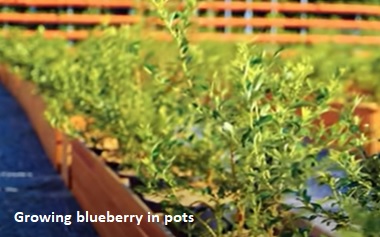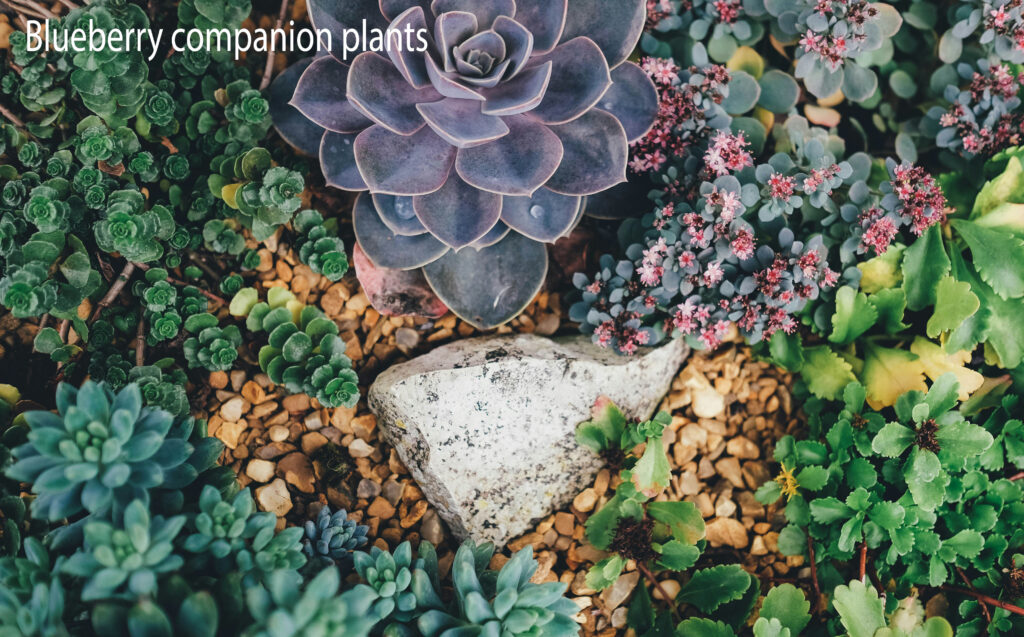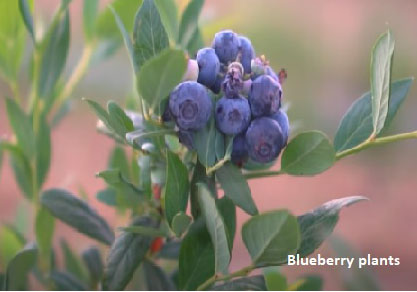Introduction to Companion Plants for Blueberries
Companion planting is a technique used to grow different plants together to boost their health, and growth, hinder pest infestation, and ensure a good garden’s health. Companion planting can be very vital and beneficial when considering it in blueberries.
Plant enthusiasts and gardeners can create a healthy and harmonious environment that will flourish the health and productivity of blueberries and the overall garden. Plant lovers can build an ecosystem that can create a healthy gardening environment.
Selecting companion plants has some basic rules and principles of mutual benefit. Wisely selected plants can provide blueberries with essential nutrients, repel pests, give shade, provide support, and attract insects beneficial for pollination.
By understanding some basic needs of the blueberries and knowing the preferences of the plants, gardeners can wisely choose the companion plants that will help their health and growth and provide structural support.
Benefits of Companion Plants for Blueberries
Companion planting provides different benefits and effects to the blueberry plants. blueberry companion plants help to make the soil healthier by creating and delivering nitrogen-fixing plants which help the soil produce essential nutrients that make the soil healthier.
companion plants for blueberries reduce the need for chemical fungicides, act as natural insect repellents, and build a healthier ecosystem. blueberry companion plants yield higher fruits by enhancing pollination, healthier soil, and attracting useful bugs and insects to the gardens such as butterflies and bees.
companion plants for blueberries can act as a shelter for the bushes, protect them from direct sunlight or harsh weather conditions, and ensure optimal growth.

Understanding Blueberry Growing Conditions
Blueberries flourish in a well-drained environment and soil that is rich in organic and animate matter and manure. Blueberries thrive in hotter conditions and full sun but they can bear and tolerate partial shade. They need wet soil consistently in the fruiting season and need consistent moisture to prevent the soil from drying out.
It is essential to understand and unlock the growing conditions for blueberries before selecting and planting a companion plant for blueberries. Blueberries require a PH level between 4.5 and 5.5 to grow and prefer acidic soil.
Understanding these conditions of the blueberries and selecting blueberry companion plants that thrive in the same condition can help gardeners grow a healthier ecosystem and yield higher fruit quantity.
Criteria for Selecting Blueberry Companion Plants
Plonk plants that will thrive in acidic conditions as blueberries, will help and supplement each other in harsh conditions. Consider plants attractive to pollinators such as butterflies and bees which will help enhance the production of blueberries and benefit them.
Choosing blueberry companion plants must go through some criteria to ensure the mutual benefit and compatibility of the plants that thrive in the same conditions. Plant nitrogen-fixing shrubs such as clover or beans which will help the soil replenish basic nutrients and complement the requirements of blueberries.
Look out for plants such as basil or marigolds that are repellent to harmful insects such as aphids or spider mites. Finally consider the water requirements, sunlight needs, and weather conditions of the companion plants for blueberries while choosing them for optimal growth.
Nitrogen-Fixing Plants: Enhancing Soil Health
Nitrogen-fixing plants and herbs take nitrogen from the air and convert it into a nutrient or form that is beneficial and usable for blueberry companion plants and also suitable for blueberries. Nitrogen-fixing shrubs and herbs can an important role in the fertility rate of the soil and will enhance the health of the soil and garden.
Plant lovers can enhance soil health, increase basic and essential nutrients in the soil, promote robust growth in the plants get abundant fruit from blueberries and companion plants for blueberries. Beans, Peas, and clover can be very good blueberry companion plants.
These plants will help gardeners to increase the overall health of their gardens and sustain a good ecosystem of their gardens. These herbs will benefit blueberries and enhance the production of fruits.
You may Like:
Pest-Repelling Companion Plants for Blueberries
Gardeners can protect their blueberry plants without using expensive chemical pesticides with the help of planting pest-repelling companion plants for blueberries. Some plants are natural pests repellent. They can deter pests by producing some natural compounds.
These can be precious and beneficial additions to a blueberry farm or garden. Plants such as basil, rosemary, and mint can be very helpful in repelling these insects without the use of chemicals.
These aromatic herbs can repel insects such as thrips, aphids, fruit flies, and other harmful insects that can damage the plants of blueberries. Marigolds can repel nematodes and other soil-borne pests by producing a scent that is repellent to these insects.
Plant enthusiasts can build and sustain a healthy ecosystem and create a thriving environment for blueberries by interplanting suitable and beneficial blueberry companion plants.

Shade-Tolerant Plants: Providing Cover and Protection
Gardners can plant flowers, plants, or shrubs that are shade-tolerant. blueberry companion plants that are shade-tolerant can be precious cover and protection for the blueberry plants, especially in areas with limited sunlight or during hot summer times. These shade-tolerant companion plants for blueberries create a micro-ecosystem.
They help the soil from drying by reducing moisture evaporation, reducing the growth of weeds, and protecting the roots of blueberries from extreme conditions or constant temperature fluctuations.
These blueberry companion plants act as living organic matter or mulch for the blueberry plants, reduce weed growth, and heal the health of soil over time. Some of the most suitable and complementing shade-tolerant blueberry companion plants are ornamental grasses, hostas, and ferns.
Wisely selecting shade-tolerant plants and bushes for blueberry gardens can help gardeners create beautiful and thriving growing conditions for blueberries and enhance the overall health and productivity of their gardens. They can build a resilient biodiversity and ecosystem for their plants, especially blueberry gardens.
Attracting Beneficial Insects to Blueberry Gardens
Plant enthusiasts can create a diverse boi system and thriving gardening environment by planting companion plants for blueberries that attract beneficial bugs. Attracting beneficial insects and bugs to the blueberries can help improve the overall health of the garden and enhance the productivity of the blueberries’ fruits.
Gardners can attract beneficial insects such as hoverflies, ladybugs, and butterflies to the gardens. They can play an important role in controlling pest population and pollinating blueberry flowers which will eventually help improve the health of the garden and productivity.
Landscapers or plant lovers can grow plants that are rich in nectar which will be a food source for the beneficial insects. It will provide food to the bugs for the whole growing season. The flowers or plants that can attract these beneficial bugs can be of different types and species.
Some blueberry companion plants can be an excellent choice to plant in the blueberry gardens. Native wildflowers such as coneflowers, asters, and goldenrods can help attract these bugs as well as some herbs like dill, thyme, and lavender.
Choosing the proper plants and herbs as companion plants for blueberries can help create a thriving planting environment, increase fruit production, and make a resilient ecosystem.
Improving Pollination with Compatible Plants
Blueberry plants or flowers are naturally pollinating to some extent. They are self-pollinating but gardeners can increase the quality and quantity of the fruits of the blueberries and other plants by planting some suitable companion plants for blueberries that are helpful in pollination.
Blueberries can benefit from cross-pollination with the help of compatible plants that can attract pollinators. Landscapers or plant enthusiasts can attract pollinators such as butterflies and bees to the garden by planting pollinator-attractive plants and increasing the production and quality of the fruits.
companion plants for blueberries that are very suitable and beneficial to attract pollinators are borage, sage, flowering shrubs such as lavender, and some wildflowers such as goldenrods, ferns, and asters.
Gardners can create a beautiful and vibrant environment and ecosystem by planting these pollinator-attractive blueberry companion plants. These plants will support robust pollination and increase the production of the harvests.

Companion Plants for Seasonal Interest and Beauty
Plant lovers and enthusiasts can choose companion plants for blueberries based on seasonal interests and beauty. Gardners can grow plants, flowers, and bushes that can add diversity, visual attraction, and additional benefits at the same time to the blueberry gardens.
blueberry companion plants can be selected based on different factors such as textures, foliage colors, bloom times, and mutual benefits to the blueberries. Incorporating suitable companion plants into blueberry gardens can create a pleasant, dynamic, and vibrant environment throughout the year.
Coneflowers and daylilies provide a beautiful and aesthetic sight during peak growing seasons. Crocuses and daffodils can create a variety of colors and enhance the beauty of the farms and gardens during the early spring when the blueberry bushes and plants awake from dormancy.
In the autumn, fall-blooming herbs and flowers such as asters and ornamental grasses can add beauty and texture to the garden of blueberries while the blueberry foliage transit from bloom to its autumn colors. Landscapers can create a beautiful view and sight by selecting suitable plants as companion plants for blueberries.
They can increase fruit production, build a harmonious environment for blueberries, and encourage a diverse ecosystem throughout the year.
Incorporating Herbs as Blueberry Companions
Different herbs have different qualities and traits that can be very effective if they are planted as blueberry companion plants. They offer a variety and range of different benefits for the blueberry plants and bushes such as culinary uses, soil improvement, and pest control.
Herbs such as yarrow, comfrey, and chamomile can create nutrient-rich soil and compost that will help promote a healthy environment for blueberries. Aromatic oil-rich herbs can be natural pest-repellent for the gardens of blueberries.
These plants have compounds that are naturally repellent to harmful insects. Whiteflies, aphids, and spider mites are some harmful pests that can be repelled through the plantation of some companion plants for blueberries.
Rosemary, thyme, and oregano can bring a variety of flavors to dishes and are used in culinary while helping and complementing the bushes and plants of blueberries. Choosing good herbs to interplant with blueberry can add different benefits to the plants, create a flavor for culinary uses, and add flavor to fresh berries.
Companion Planting Tips and Best Practices for Blueberry Gardens
Gardners can implement some methods and practices to maximize the benefits and get out the most of the blueberry companion plants:
- Diversity is key:
Incorporate plants with different benefits and abilities as companion plants for blueberries. Plant a variety of plants with different functions such as pollinator attractors, nitrogen-fixers, and pest repellents to fabricate a resilient ecosystem.
- Succession plan:
Choose plants as blueberry companion plants that provide benefits and interest to blueberries throughout the year. Select fall-blooming perennials, spring bulbs, and wildflowers to nourish the gardens the whole year and maintain an appealing visual sight.
- Consider space and growth habits:
Do not select plants that may compete with blueberries for sunlight, nutrients, or space. Plants herbs and flowers that complement and help blueberries. Ensure proper spacing between the plants and avoid overcrowding.
- Pay attention to soil pH:
To ensure optimal health and growth of the blueberries and companion plants of the blueberries, choose plants that are compatible with similar conditions as blueberries. Choose plants that are suitable with a pH level between 4.5 and 5.5 and acidic soil.
Examine the plants of blueberries and companion plants for blueberries regularly. Check for any issue such as insects or any disease. Implement proper methods and practices to prevent any type of problem that can hurt the garden. Take suitable action to prevent infestation and sustain a healthy gardening environment.
Following the above tips and tricks, gardeners can build a beautiful and thriving sustainable blueberry garden that will be very beautiful and productive.
Maintenance and Care of Blueberry Companion Plants
To promote maximum growth and optimal production in the blueberry garden and the companion plants for blueberries, ensure proper care and maintenance of the blueberries and companion plants. Gaugae proper watering practices, fertilize regularly, prune bad leaves, and mulch the garden to increase health and productivity.
Common Mistakes to Avoid in Blueberry Companion Planting
A good selection of blueberry companion plants can be a positive point for a blueberry garden and increase the chance of success but failure to detect some mistakes can harm the beautiful garden. These mistakes can be overplanting or overcrowding, improper plant selection, neglect of soil properties such as pH levels and acidic factors, and not monitoring pests and disease problems.
Companion Planting for Container Blueberry Gardens
Run proper research and find proper companion plants for blueberries that can complement small-scale blueberry plants grown in pots or containers. Search suitable companion plants, optimize space, examine growing conditions, and obtain proper container gardening tips to grow healthy small-scale blueberry gardens.
Sustainable Practices in Blueberry Companion Planting
Implement eco-friendly and sustainable gardening practices while choosing blueberry companion plants. Do not waste water, use methods that are helpful in water conservation. Implement proper water practices. Use natural materials to enrich the soil such as composting through organic humus. Use organic pest controls and promote biodiversity to build a beautiful and productive garden.
These methods can help gardeners create resilient and environmentally friendly blueberry garden ecosystems.
Conclusion: Cultivating Harmony in Blueberry Gardens
companion plants for blueberries can offer a holistic perspective and approach to blueberry gardening. These plants can foster stunning harmony and balance within the garden ecosystem and environment. They can bring a lot of benefits to the blueberry garden and nourish a healthy planting ecosystem.
Gardners can create and build thriving blueberry gardens that are beautiful and productive by selecting proper and suitable blueberry companion plants. Interplants herbs and flowers that provide nutrients, attract pollinators, repel insects, and enhance soil health and condition.
By selecting and integrating companion plants for blueberries carefully, and planting diverse species of different herbs and shrubs in the gardens, plant lovers can mimic a natural planting environment and ecosystem.

Plant enthusiasts can integrate the power of biodiversity into the gardens and promote the vitality and health of their blueberry plants and gardens. Blueberries can benefit from the presence of good blueberry companion plants whether grown in traditional garden beds, containers, pots, or even as part of permaculture designs.
Interplanting can be a good and positive point for blueberry gardens if the companion plants for blueberries are chosen wisely.
Applying these methods and practices to blueberry companion plants, gardeners must focus on and remember techniques that are sustainable and eco-friendly. Use methods and techniques that are beneficial to the blueberry garden and also complement the companion plants for blueberries and do not harm the ecosystem or environment.
Remember the principles of adaptation, stewardship, observation, and conservation to nourish a stunning and productive blueberry garden. Plant lovers and landscapers can build and cultivate resilient and sustainable blueberry gardens that will produce abundant results for years to come by choosing the right and sustainable practices.
Interplanting companion plants into blueberry gardening not only benefits blueberry plants and blueberry companion plants but also helps to heal the overall health of the garden.
They contribute to the overall health of the soil and environment by reducing the use of chemical pesticides. They help to promote ecological balance in the surroundings by enhancing the health of the soil and reducing reliance on chemical inputs.
Gardners can create vibrant, resilient, and thriving blueberry gardens that will nourish and enhance both body and soul.
Whether you are just starting or you are a veteran and seasoned gardener, explore the world of companion plantations in your blueberry garden. Using some methods, and techniques, and applying some practices can help you create a stunning blueberry garden without the use of any chemical-based inputs.
You can preserve your surroundings by implementing these techniques in your garden. companion plants for blueberries can help you build a vibrant and resilient ecosystem that will harvest results for the years to come. They will delight your senses and nourish your soul.
Also Read:
What is a good companion plant for blueberries?
Sage, comfrey, chamomile, and yarrow, are some of the best plants and herbs that can accompany blueberries.
What should not be planted near blueberries?
Kale, peas, cauliflower, beans, wildflowers, Brussels sprouts, Beets, and Garlic are some of the herbs that must not be planted near blueberries.
Can I plant strawberries and blueberries together?
Yes, you can harbest blueberries and strawberries together. Blueberries and strawberries can become best companion plants.
What grows well next to blueberries?
Many plants can become good blueberry companion plants. Plants that require same soil and weather conditions such as rhododendrons or azaleas, gooseberries, and cranberries.


5 thoughts on “10 companion plants for blueberries: Powerful Gardener’s Guide”